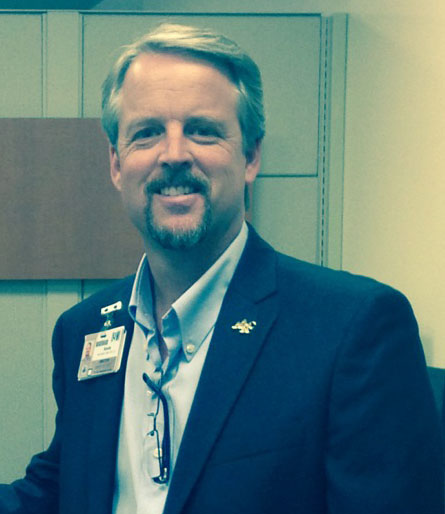 Kevin McQueen
Kevin McQueenPatient safety has always been a priority at hospitals across the country, but with a growing body of evidence pointing to the best ways to reduce the risk for patient harm, more and more facilities are hiring patient safety officers to oversee a more concerted effort to ensure patients do not come under undue risk.
As bedside practitioners who work to keep patients safe everyday on the job, respiratory therapists may be eligible for these positions, especially if they return to school to earn an advanced degree in a related field.
Kevin McQueen, MHA, RRT, director of safety/environment of care and patient safety officer at Tri-City Medical Center in Oceanside, CA, serves as a case in point. In the following interview he explains how he segued into the area and what he believes other therapists would need to do to follow in his footsteps.
How and why did you get into the profession and what other positions did you hold prior to becoming your hospital’s patient safety officer?
I started my RT training back in 1989, soon after I got out of the Air Force. I had spent four years in the military as a critical care medical specialist working in emergency departments and ICUs, where I often cared for patients on ventilators. During my time in the service I was always fascinated with airway management and caring for people with breathing problems. My military training provided me with excellent knowledge and skills that I have applied at almost every level of my career.
Throughout my years as an RT I have held many leadership roles, both inside and outside of the normal career path for a respiratory therapist. Strange as it may seem, my initial leadership role was not in respiratory care. Instead, my first supervisory position was as the operations manager of the second busiest emergency department in San Diego County. The role was both challenging and rewarding, as it required me to lead 120 employees, of which most were registered nurses.
How did you get your current job and what, if any, special training and/or qualifications did it require?
In 2012, shortly after I completed my bachelor’s degree in health care management, I was approached by the chief nursing executive (CNE) at the hospital where I work and was asked if I would be interested in transitioning into risk management as the patient safety officer. The CNE felt the combination of my clinical knowledge from being an RT and my leadership experience in both the ED and respiratory care departments made me an excellent candidate to be the hospital’s patient safety officer (PSO).
To help me in my new role the hospital administration sent me to Chicago to attend specialized training in patient safety and risk management through the American Association for Healthcare Risk Managers. Following my first year as the PSO, I decided to return to school and complete my master’s degree in health care administration through Colorado State University-Global Campus.
In 2015, I became the director of safety/environment of care and patient safety officer, which encompasses all aspects of safety throughout the medical center and all affiliated offsite clinics.
What does the job entail and how has your background as a respiratory therapist helped to prepare you for the role?
The safety officer position is highly regulated by numerous health care and governmental agencies, such as The Joint Commission, Centers for Medicare and Medicaid Services, Occupational Safety and Health Administration, National Fire Protection Association, and the local state health department. The position requires a constant state of vigilance of monitoring and observing things that may place individuals in harm’s way, such as faulty fire suppression systems, blocked egress corridors, or poorly designed processes. My RT training taught me the importance of having a “watchful eye” when caring for patients on life support or those who were critically ill.
What are the biggest challenges and rewards in holding this position?
The most challenging aspect of my position is the endless number of regulations that often crosswalk between agencies. The greatest rewards are being able to help make a difference for patients, visitors, and employees by assessing for risks and designing safer systems and processes.
What advice do you have for other therapists who might like to explore career opportunities in the patient safety area?
RTs that want to advance into health care administration or patient safety roles need to get involved. Volunteer to serve on as many hospital-wide committees as possible so that you gain knowledge of how the entire multidisciplinary system works and at the same time get noticed by administrative leaders. Obtain education related to project management, leading effective teams, patient safety, risk management, systems design, regulatory compliance, and human factors. Above all, be willing to accept roles that may be outside of your comfort zone.





